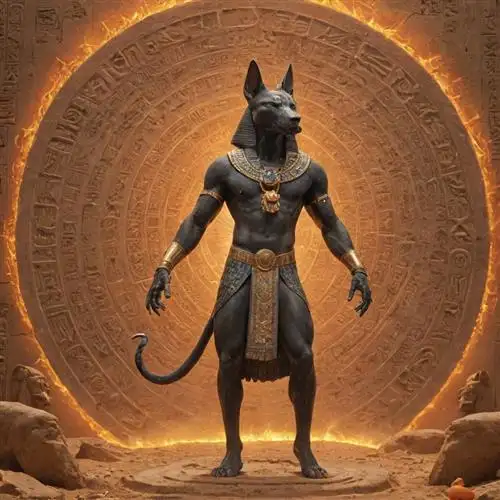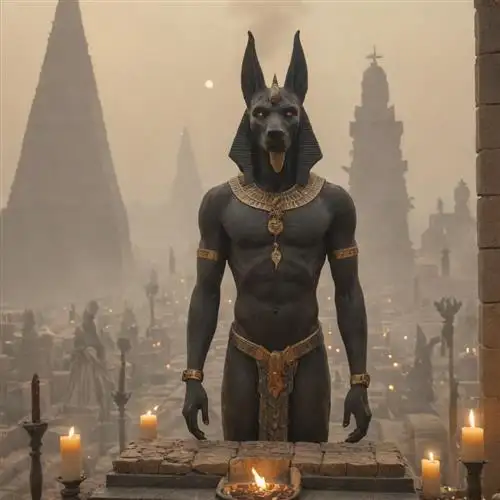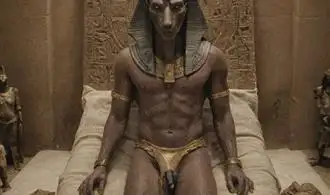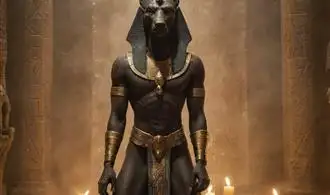
The Enigmatic Origins of Anubis
The origins of Anubis, the ancient Egyptian deity associated with the afterlife, have long been a topic of fascination and scholarly debate. Considered one of the oldest deities in the Egyptian pantheon, Anubis' exact beginnings remain shrouded in mystery, with multiple theories and interpretations surrounding his emergence and early development.
One of the prevailing theories suggests that Anubis may have originated as a jackal-headed deity worshipped in pre-dynastic Egypt, particularly in the region of Cynopolis, where the jackal was revered. This jackal-god was likely associated with the deceased and the process of mummification, as jackals were often observed scavenging in the desert, which was seen as the realm of the dead. As Egyptian civilization and religious beliefs evolved, this early jackal-deity may have been syncretized with other deities, eventually coalescing into the distinct Anubis figure we recognize today.
Another hypothesis proposes that Anubis may have been influenced by earlier, more localized funerary deities, such as Wepwawet, another jackal-headed god associated with the dead and the afterlife. The similarities between Anubis and Wepwawet have led some scholars to believe that Anubis may have emerged as a regional variation or interpretation of this earlier deity, reflecting the diverse religious traditions that existed across ancient Egypt.
The iconography and symbolism of Anubis also offer clues to his enigmatic origins. The jackal-headed form of Anubis is believed to represent the animal's natural habitat in the desert, which was seen as the realm of the dead in ancient Egyptian cosmology. The black color of Anubis' skin is often interpreted as a reference to the color of mummified flesh or the fertile black soil of the Nile Valley, further cementing his association with death, rebirth, and the cycle of life.
The Roles and Responsibilities of Anubis
Anubis, the ancient Egyptian god associated with mummification and the afterlife, played a crucial role in the complex and intricate belief system of ancient Egyptian civilization. As one of the most prominent deities, Anubis' responsibilities extended far beyond the realm of the dead, encompassing a multitude of sacred duties and symbolic representations.
At the heart of Anubis' responsibilities was his role as the guardian of the necropolis, the sacred burial grounds where the deceased were laid to rest. He was believed to be the guide who escorted the dead to the afterlife, ensuring their safe passage through the perilous journey of the underworld. Anubis was tasked with carefully examining the heart of the deceased, weighing it against the feather of truth, to determine the worthiness of the individual for eternal life.
Additionally, Anubis was responsible for the mummification process, overseeing the intricate and sacred rituals that were performed to preserve the body and prepare the deceased for the afterlife. He was often depicted as a jackal-headed deity, standing guard over the embalming table, ensuring that the mummification rites were carried out with the utmost care and precision.
Beyond his duties in the afterlife, Anubis also played a significant role in the divine order of the Egyptian pantheon. He was revered as a protector, guarding the tombs and sacred spaces from desecration. Anubis' watchful gaze was believed to extend to the living, offering guidance and protection to those who sought his favor.
Interestingly, Anubis' association with the jackal or dog-like creature was not merely symbolic. These animals were believed to have a heightened sense of smell and were often found scavenging in the necropolis, leading to the belief that they were intimately connected to the realm of the dead. Anubis' jackal-headed form, then, was a physical representation of his role as the guide and protector of the deceased.
Anubis in Ancient Egyptian Mythology
What You Didn't Know About the Anubis Deity
Anubis in Ancient Egyptian Mythology
Anubis, the jackal-headed deity, held a prominent place in the pantheon of ancient Egyptian mythology. As the god of the dead, embalming, and the afterlife, Anubis played a crucial role in the rituals and beliefs surrounding death and the journey to the afterlife.One of the most distinctive aspects of Anubis was his physical appearance. The jackal-like head and canine features were believed to be symbolic of his association with the desert, where jackals were often seen scavenging around cemeteries and tombs. This connection to the arid and desolate landscape was seen as a reflection of Anubis' domain over the realm of the dead.In ancient Egyptian funerary practices, Anubis was responsible for the crucial process of mummification. As the patron of embalming, Anubis would oversee the elaborate rituals and procedures involved in preserving the body of the deceased, ensuring a smooth transition into the afterlife. The jackal-headed god would carefully wrap the body in linen and apply the necessary oils and preservatives, transforming the mortal remains into a sacred vessel for the soul.Anubis' role extended beyond the physical preparation of the body. He was also believed to be the guardian of the necropolis, the sacred burial grounds where the dead were laid to rest. It was Anubis who would guide the deceased through the dangerous and mysterious journey to the afterlife, ensuring their safe passage and judging the worthiness of their soul.One of the most significant rituals associated with Anubis was the "Weighing of the Heart" ceremony. In this ritual, the heart of the deceased was weighed against the feather of Ma'at, the goddess of truth and justice. If the heart was found to be pure and balanced, the soul was deemed worthy of eternal life in the afterlife. Anubis would be present, carefully monitoring the proceedings and guiding the deceased towards their final judgment.Anubis' importance in ancient Egyptian mythology extended beyond his role as the god of the dead. He was also associated with other deities, such as Osiris, the god of the underworld, and Bastet, the goddess of cats. These interconnections within the Egyptian pantheon demonstrate the complex and multifaceted nature of Anubis' divine powers and responsibilities.The Iconography and Symbolism of Anubis
Anubis, the Egyptian deity of the dead, is one of the most recognizable figures in ancient Egyptian mythology. The iconography and symbolism associated with Anubis are both rich and complex, providing insight into the ancient Egyptians' beliefs and practices surrounding death and the afterlife.
Anubis is typically depicted with the head of a jackal or wild dog, and a human body. This distinctive appearance is believed to be rooted in the ancient Egyptians' observations of the behavior of these animals, particularly their tendency to scavenge around cemeteries and gravesites. The jackal-headed form of Anubis was also associated with the god's role as the guide and protector of the deceased, as these animals were seen as the guardians of the necropolis.
The black color of Anubis' skin is another important aspect of his iconography, as it is believed to represent the color of the fertile Nile soil, which was essential for the regeneration of life. This color was also associated with the process of mummification, as the black resin used in the embalming process was thought to be a symbolic representation of Anubis himself.
Anubis is often depicted holding a was scepter, a symbol of authority and power, which reflects his role as the presider over the embalming and mummification process. He is also frequently shown holding an ankh, the symbol of life, which represents his role in guiding the deceased into the afterlife.
Another important symbol associated with Anubis is the canopic jar, which was used to store the internal organs of the deceased during the mummification process. Anubis was believed to be responsible for the protection and preservation of these jars, ensuring the safe passage of the deceased into the afterlife.
The Cult and Worship of Anubis
The cult and worship of Anubis, the ancient Egyptian deity associated with mummification and the afterlife, was a central aspect of ancient Egyptian religion. Anubis was revered as the guardian of the dead, responsible for overseeing the embalming process and guiding the deceased through the dangerous journey to the afterlife.
The Anubis cult was primarily centered in the city of Cynopolis, where the god was believed to have his primary temple and cult center. However, Anubis was revered throughout ancient Egypt, with his shrines and statues found in many other cities and necropoli. The cult's priests were responsible for performing the complex rituals of mummification and guiding the dead through the underworld.
One of the most important aspects of the Anubis cult was the rituals and ceremonies performed during the embalming process. Priests would carefully perform the mummification rites, invoking Anubis to ensure the successful preservation of the deceased's physical body. This was seen as essential for the soul's journey to the afterlife, as the Egyptians believed the body and soul were inextricably linked.
In addition to his role in mummification, Anubis was also closely associated with the psychopomp, or guide of souls, in the Egyptian afterlife. Anubis was believed to weigh the heart of the deceased against the feather of truth, determining their worthiness to enter the afterlife. This ritual, known as the "Weighing of the Heart," was a critical component of the funerary rites and the journey to the afterlife.
The Anubis cult also played a significant role in the funerary practices of the ancient Egyptians. Statues and images of Anubis were often placed in tombs and alongside the deceased, serving as protectors and guides for the soul's journey. The cult's priests would also perform rituals and ceremonies at the tomb, ensuring the safe passage of the deceased into the next life.
















